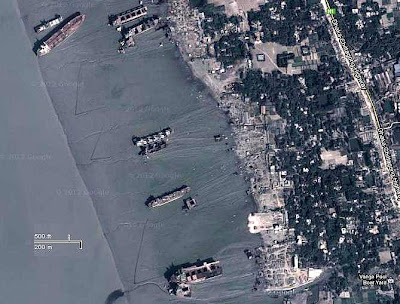I heard about
the ship breaking yards in Chittagong a while ago. The reports were not
necessary good . Apparently Greenpeace has visited the yards a couple of years
ago and published some reports about the conditions around the yards – not
good either. Basically the ship breaking yards are the last stop for any super tanker,
cargo ship or any other vessel. Ships are being de-assembled and every part is
either being re-used or melted in the steelworks on the other side of the highway. There are some other yards in
India, Pakistan and somewhere in Africa – well you get the story: countries
with cheap(est) labour cost and without any OH&S and any environmental
restrictions. The guidebook said that a visit is probably impossible as they
don’t let foreigner in anymore…
So, here I am
in Chittagong. I am fascinated by the sheer scale of the yards so there should
be a way to get in. Just call me Bond, James Bond. I got a tip to talk to some people in
one of the hotels, they might have taken some people into the yards, but the
controls are hard these days. The guy has left the hotel but somebody knew a friend
of a friend who knew somebody at the yards, and he ‘by coincidence’ also was a
driver. Done deal let’s go, first hurdle done, there was somebody who was
willing to drive out there. After a longer drive through the industrial area
along the Dhaka-Chittagong highway, we made a sharp turn into a little dirt
track. The industry around there is typically re-using the parts of ships and
you can see shops full of pipes, tanks, generators, windows,
instruments…anything you can imagine. The dirt track led to some gates, heavily
secured by barbed wire and watch towers. I was not welcomed which even I could figure
out with my limited (none existent) Bangla skills. Even the question about some
(monetary) ‘help’ for their families did not open the doors – so somebody had definitely
got into trouble before. Usually some cash opens any door in Bangladesh. James, too
early to give up. So the driver/fixer pulled over and disappeared in a shop and
returned with two locals. They looked at me and just shook their heads, no this
foreigner does not look like a local. The foreigner (me) smiled to them nicely and assured
that he was not an activist but only a travelling architect. One called another
one who knew a friend’s uncle at one of the yards and after long negotiations,
and only with the assurance to not (oh no!) take any pictures there was some
movement. So I had to leave my camera in the car and a suspicious supervisor
took us into the yard. Wow, unbelievable. The scale of the ships is mind blowing.
At high tide, ships are being winched
over the slippery mud onto shore and there they are towering above you. Hundred
meters of ships, maybe 70m high, sit on the mud. Some of them are sliced open
on one side, some of them are chopped off entirely. Some have only the bridge
tower remaining – it looks scary as it looks dangerously high and any piece is unsupported.
No problem assured me the worker, before the last bit of the steel monster
falls over, the thousands of workers in flip flops take the burners and leave
the tipping ship – god bless them.
The scale is
just amazing, have you ever seen a super tanker sliced open along the side? It
looks like the technical books which show an exploded axonometric of the ship –
but this one is real. I was looking around but I couldn’t see any major oil
spills. I can understand the environmental concerns about cutting a super
tanker apart, but what is the difference to when they clean the tanks in the
open sea? If we put the OH&S issues aside (and that is not easy as apparently people die here more than anywhere else) – a sign at the gates said: no women and child worker allowed - every part is being re-used.
Probably the best recycling facility you can imagine. Every single part is
taken apart and finds literally a new home. Are we doing the same for example with our
cars?
On the way out
I could do some shots from outside over the barbed wires, but that was unfortunately it. more images
 |
| The winch to pull the massive ships over the mud to shore |
 |
| source: google |
 |
| source: google |
Not far from
the road, we found an area full of emergency rescue boats. As they are
typically made from fibre glass and not from steel, the future re-use wasn’t
clear and the ended up in a dried out basin. On the other hand, I am sure one day
you will see a happy fisherman in a refurbished rescue boat going fishing, good
on him.
 |
| Picture taken by Rich - have a look at his blog (link above) |









No comments:
Post a Comment